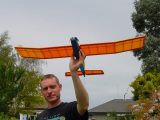
|
"Tangerine"
Scratch-built parkflyer
|
Specifications
|
Wingspan
|
910mm (36")
|
|
Wing Loading
|
21gm/dm
2
(7oz/sqft)
|
|
Flying Weight
|
260gm (9.3 oz)
|
|
Motor
|
Speed 300 direct drive
|
|
Propeller
|
Graupner folder 120mm x 60mm (4.7" x 2.3")
|
|
Speed Control
|
10A with brake (no BEC)
|
|
Battery
|
4 x Sanyo KR600AE NiCad (4.8V)
|
|
Receiver
|
GWS 4P
|
|
Servos
|
2 x Cirrus CS-20BB
|
|
Controls
|
Rudder, Elevator, Motor
|
|
Construction
|
Balsa, covered with Airspan (lightly doped)
|
This is my second scratch-built design. My goal was to produce a light-weight
plane that could be powered with a small motor. Originally I intended to use a
Mabuchi FK-050SH motor rescued from a broken CDROM drive, geared down to drive
a high-pitch prop. However, earlier tests on my "Sandfly" showed that this
motor would not deliver enough power. Therefore I decided to fit a Speed-260
motor with direct drive to a Graupner 4.7" x 2.3" folding prop.

The Speed-260 was barely powerful enough to keep the plane aloft. Unfortunately
after only three flights the motor overheated and melted its plastic endbell.
Driving the 4.7" x 2.3" prop on 4.8V caused current draw to approach 3 Amps,
three times higher than the motor's point of best efficiency. I then realised
that a better motor was required, so I installed a Speed-300 unit. This motor
draws about 5 Amps static, but is efficient at such power levels. The extra
power available permits a good climb rate, and it cruises at half-throttle.
Hand launching is easy, with plenty of thrust for a steep climbout. Flight
duration is from 8 to 14 minutes depending on flying style.
 Combining a Speed-300 motor and 4 x 600AE cells has proven to be a good match
for this model. 600AE cells have excellent energy to weight ratio, and are less
expensive than most smaller cells. The only problem I had was finding a speed
controller that would cut off at the required 4.0 volts. I tried a GWS #100A,
but it was heavy and inefficient (frame-rate) and had an awkward arming button.
Therefore once again I built my own
ESC
, this time without a BEC (the receiver and servos run direct from the 4.8V
motor battery).
Combining a Speed-300 motor and 4 x 600AE cells has proven to be a good match
for this model. 600AE cells have excellent energy to weight ratio, and are less
expensive than most smaller cells. The only problem I had was finding a speed
controller that would cut off at the required 4.0 volts. I tried a GWS #100A,
but it was heavy and inefficient (frame-rate) and had an awkward arming button.
Therefore once again I built my own
ESC
, this time without a BEC (the receiver and servos run direct from the 4.8V
motor battery).
Replacing the servos and ESC with lighter equipment could trim 15-20gms off the
total weight. However, I doubt such a small improvement would be very
noticable. An inline gearbox should markedly improve performance, as the motor
could then drive a larger prop which would be more efficient at low speeds. I
may try this if I can get a suitable gearbox for a reasonable price.

|

|
|
a nice snug fit!
|
Custom-built ESC
|
And now some in-flight pictures...
 1st April, 2001. Found out air can be stronger than balsa.
1st April, 2001. Found out air can be stronger than balsa.
back








 1st April, 2001. Found out air can be stronger than balsa.
1st April, 2001. Found out air can be stronger than balsa.